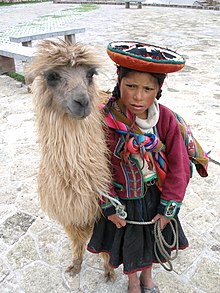Berserk male syndrome
Berserk male syndrome (BMS), also called berserk llama syndrome, describes a particularly aggressive behavior of some young, mostly male llamas and alpacas towards people as a result of incorrect imprinting . The syndrome occurs with the onset of sexual maturity.
The term was introduced in 1980/1981 by the llama breeder Paul Taylor, who described it as the result of a series of atypical interactions between animals and humans, such as when the llamas are bottle-fed or when people “ cuddle ” with the young animals and not eat the animal Keep your distance , which can initially lead to a lack of escape distance for the herd animals from humans.
With increasing sexual maturity, this imprint on people can lead to aggressive and dangerous dominance behavior for people. An essay from 2014 suggests as an alternative name for the syndrome aberrant behavior syndrome or even novice handling syndrome (German for "beginner handling syndrome") to make it clear that the behavior disorder is caused by incorrect rearing by humans. As a result, it does not only occur in males.
An early castration of the male lama before sexual maturity can lead to the avoidance of aggressive behavior, although the timing of the castration is controversial. If the animal is extremely aggressive, euthanasia may also be necessary.
Individual evidence
- ↑ a b Chris Cebra, David E. Anderson, Ahmed Tibary, Robert J. Van Saun, LaRue Willard Johnson: Llama and Alpaca Care: Medicine, Surgery, Reproduction, Nutrition, and Herd Health . Elsevier Health Sciences, 2014, ISBN 978-0-323-24291-2 , pp. 48 .
- ↑ Chris Cebra, David E. Anderson, Ahmed Tibary, Robert J. Van Saun, LaRue Willard Johnson: Llama and Alpaca Care: Medicine, Surgery, Reproduction, Nutrition, and Herd Health . Elsevier Health Sciences, 2014, ISBN 978-0-323-24291-2 , pp. 721 .
- ↑ Chris Cebra, David E. Anderson, Ahmed Tibary, Robert J. Van Saun, LaRue Willard Johnson: Llama and Alpaca Care: Medicine, Surgery, Reproduction, Nutrition, and Herd Health . Elsevier Health Sciences, 2014, ISBN 978-0-323-24291-2 , pp. 50 .
